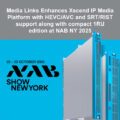Published in Content & Technology, Australia – July / August, 2015 – Media Links is an innovative developer and manufacturer of broadcast network infrastructure solutions. The company offers broadcasters, network service providers, and sporting event hosting companies’ cutting edge technology, enabling them to economically convert transport and manage the complete suite of broadcast signals. Whether it’s video, audio, data, or all three, onto their multi-service networks.
Media Links’ core technology is being deployed for high profile sporting events not only here in Australia, but with other global companies including a major US telecom video network in the US, along with players in Europe, Japan, South Korea, Mexico, South Africa, and South America. The Media Links media over IP technology has been the backbone of the last handful of Soccer World Cups, winter and summer Olympic events, major US American Football events, and Incheon Asian Games, and many other high profile global sporting events. In each case, the Media Links solutions actualise broadcast signals out from these events on a global scale.
I recently enjoyed the privilege of meeting the people at Media Links Australia, and was shown around the Media Links labs. Here I witnessed what is becoming a mainstay in the evolution of broadcasting media transfer.
With high bandwidth media transport, Media Links piggyback on fibre-optic network infrastructure belonging to major telcos. Organisations usingTelstra’s new Digital Video Network in Australia will have the technology built-in standard. Utilising video over IP transport technology, the company’s solutions offer next-to-zero latency and a 99.99% quality of service (QoS). The Media Links equipment adheres to SMPTE-2022 video-over-IP standards allowing interoperability between different vendors, and at the same time providing a future-proof platform as the field develops. As more vendors jump aboard the standard, we’ll see proprietary systems fall by the wayside. In support of its pioneering work, Media Links was awarded a 2014 Technology and Engineering Emmy® Award for Standardization and Productization of JPEG2000 (J2K) Interoperability.
The beauty of the system allows a cameraman to plug into the Digital Video Network via Media Links’ extremely space and cost effective MD8000 series hardware. This feed can then instantaneously traverse the network to any other site or tenant on the platform such as a television studio in Melbourne or disaster recovery centre in Sydney – all in real time.. There are two streams of video, and if one stream goes down the other will continue to feed that video.
Consequently the system is managed nationally by the telco’s fibre network. Customers can call into a help desk and schedule services from one point to another at a particular point in time. Alternatively, carriers can offer a multi-tenant arrangement where each customer has the ability to switch services to and from wherever they want within the service framework that they’ve purchased from the telco. Customers have their own screen and control software provided by Media Links, their own visibility, and their own ability to manage their component of the network.
With such immediate transportability provided on site, it raises the question of whether this could spell the end of outside broadcast appliances. The Media Links team doesn’t believe so. The team sees this as part of a transformation, because the OB crew is still an important creative production endeavour. Producers still need to control how the game unfolds and how the story is told. There are possibilities for new, creative tool-sets within a broadcaster. They could, for example, shoot the whole field in one camera and view it at a remote studio or location and actually see the action clearly. You could probably even do some sort of logging of the whole game remotely instead of being there. Economically, the system negates the need for a satellite uplink. Utilising existing optical networks decimates costs, all without the latency inherent with satellite transfers.
During SMPTE15, Media Links with be demonstrating various aspects of the system, including 4K high bandwidth delivery, ‘Live to File’ workflow, and H.264 compression codec for distribution. With 4K delivery, Media Links utilise what’s known as ‘square division’, which is basically four 3G signals with those signals stitched together. A single 3G signal would be 2048 by 1080, with those four quadrants stitched into a single image at the receiving end. Proof of concept runs have already been instigated within Victoria and New South Wales. ‘Live to File’ allows workflows to remain completely within the IP domain, negating the need to convert to serial digital video and then back to IP until final delivery.
The Media Links team is looking toward a future where the post-production process will be an end-to-end IP environment. With the SMPTE 2022 standard allowing broadcasters to transition toward becoming ‘IP islands’ relaying capture instantaneously to relevant destinations. The 20-strong Media Links Australia team are seasoned industry players that have come from parts of the broadcast field and the telcos. It takes this mature understanding of the field to apply such an evolution to the established industry. But so far, the economic, physical space consideration, and sheer versatility aspects of the system put Media Links at the forefront of broadcast media distribution.
Article courtesy of Content & Technology, writer Brad Watts, issue July/August, 2015






